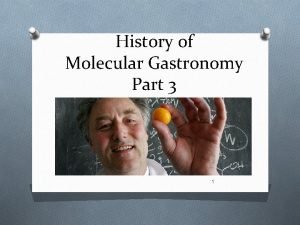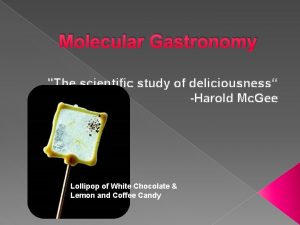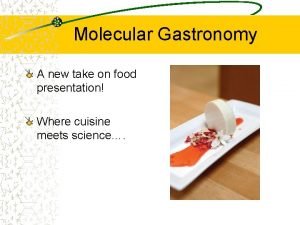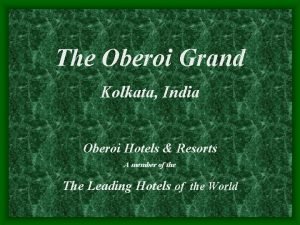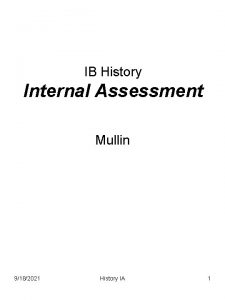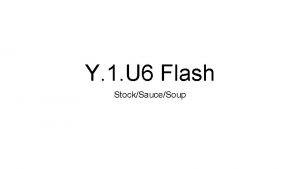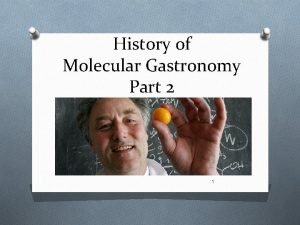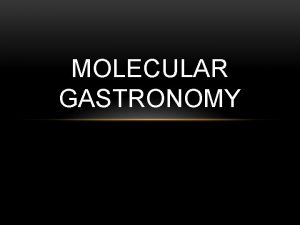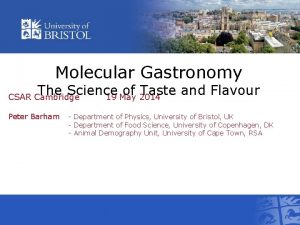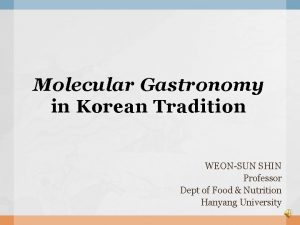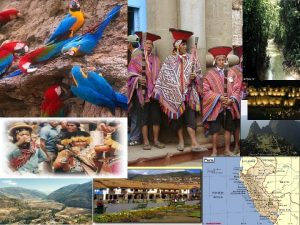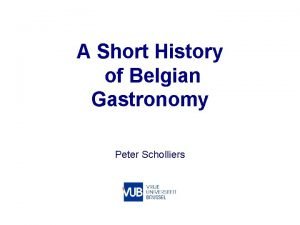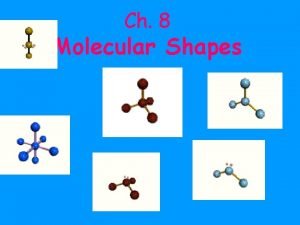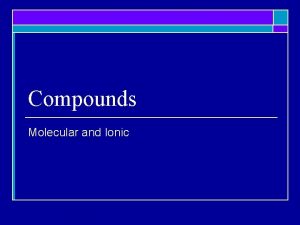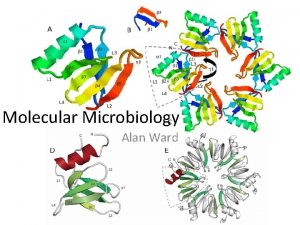History of Molecular Gastronomy Part 3 1 Grand

















- Slides: 17

History of Molecular Gastronomy Part 3 1

Grand Hôtel or Cuisine Classique George Auguste Escoffier (1846– 1935) was a French chef, restaurateur and culinary writer who popularized and updated traditional French cooking methods. He is a near legendary figure among chefs and gourmets, and was one of the most important leaders in the development of modern French cuisine. He created many famous dishes. The Pêche Melba in honour of the Australian singer Nellie Melba and the Tournedos Rossini, in honour of the Italian composer Gioacchino Rossini are still served today. 12

Nouvelle Cuisine Fernand Point (1897 – 1955) was a French restaurateur and is considered to be the father of Nouvelle French cuisine. From his restaurant "La Pyramide" out of the way south of Lyon, trained a generation of French master chefs: Paul Bocuse, Jean and Pierre Troisgros, and Georges Perrier. From its kitchen came the modern lightly thickened sauces, baby vegetables, while over adornments from previous trends were removed. 13

California Cuisine (1944 ), of the restaurant Chez Panisse, is usually credited with originating California cuisine and retains the reputation of offering the ultimate California cuisine experience. Her cuisine emphasizes the freshest ingredients which are in season and are procured solely from local farms. The emphasis of California Cuisine is on the use of fresh, local ingredients which are often acquired daily at farmers markets. Menus are changed to accommodate the availability of ingredients in season. Some restaurants create a new menu daily. Alice Waters is credited with originating California cuisine. 14

Fusion The term “fusion” refers to the combination or blending of ingredients or techniques that are originally from foreign cultures. Wolfgang Puck (1949 ), of Spago in Beverly Hills, is internationally known for his fusion of occidental and asian cuisines. 15

Deconstructivism Charlie Trotter(1959 ) is a Chicago chef and restaurateur who has developed many dishes where the traditional components are broken down into basic parts to enhance the degustation experience. 16

Molecular Gastronomy; An approach to cooking where the food is broken down to its Heston Blumenthal is the chef and molecular components and owner of The Fat Duck in England. presented in unusual and disconcerting manner. His passion for food was kindled at the age of 10. As a young adult he spent his holidays on gastronomic pilgrimages to France and his nights were dedicated to his twin obsessions, kick boxing and cooking. Finally, in 1995, aged 29, he opened The Fat Duck in Bray and world spread fast. The Good Food Guide awards 9 points (out of a possible 10) Herve This (1955) is a French physical chemist. 17

“Molecular” relates to simple or basic structure or form while “gastronomy” is the art of fine dining; the science of gourmet food and drink. Together is the application of science to the basic cooking and traditional methods, the study and application of chemistry, physics, and other scientific principles on its processes, preparation, and materials. 18

The term was invented by the Hungarian physicist Nicholas Kurti in a 1969 presentation to the Royal Institution called "The Physicist in the Kitchen", and popularized by his collaborator the French scientist Hervé This. 19

The fundamental objectives were: • Investigating culinary and gastronomical proverbs, sayings, old wives tales. • Exploring the recipes • Introducing new tools, ingredients and methods into the kitchen • Inventing new dishes • Using molecular gastronomy to help the general public understand the contribution of science to society 20

Molecular gastronomy has become a merging scientific tools and techniques with culinary arts. For example utilizing tools such as centrifuges, liquid nitrogen, microscopes or lasers in the preparation of food items. Molecular gastronomy has manifested itself in the modern restaurant trade in three ways. First, it has led to a better understanding of why traditional approaches to cooking work (or do not). For example, science has led to an improved understanding of how to make a perfect soufflé. Second, it has led to novel pairings of foods, such as white chocolate and caviar. The Fat Duck has used the discovery of unusual combinations of ingredients to earn three Michelin stars, one of only two British restaurants that have received this honor. Third, it has led to novel methods of food preparation. 21

Molecular gastronomy is a relatively new term, one that has caused much confusion and controversy. Some of the confusion comes from trying to put a modern spin on a much older word. That word is gastronomy, which, since the 19 th century, has described the art of selecting, preparing, serving and enjoying fine food. If preparing food is an art form, then it must be an activity requiring creative skill and imagination, not technical expertise. And yet gastronomy, like astronomy and agronomy, say, seems to describe a rigorous, scientific field of study. 22

In 1989, Nicholas Kurti and Hervé This decided to intentionally emphasize the scientific elements of cooking by coining the term molecular and physical gastronomy. The addition of the words "molecular" and "physical" cast cooking in a new light. It was no longer magic and artistry, but molecules obeying well known processes that describe the behavior of all solids, liquids and gases. Suddenly, the "art" of selecting, preparing, serving and enjoying fine food became the "science" of doing so. This described molecular and physical gastronomy as the physics and chemistry behind the preparation of a dish, and he began testing the scientific validity of cooking rules and old wives' tales in a research environment that was part kitchen, part high tech lab. He also organized the first International Workshop on Molecular and Physical Gastronomy in 1992 and presented the first doctorate in molecular and physical gastronomy at the University of Paris in 1996. 23

Not everyone embraced the field. Some critics complained that the new field overemphasized the scientific processes of cooking and failed to acknowledge intangible aspects of the craft, such as a chef's intuition or spontaneity. Others simply said it was too difficult and complex for average cooks in average kitchens. One such critic has been William Sitwell, the editor of Waitrose Food Illustrated. Sitwell argues that the modern interpretation of gastronomy lies beyond the grasp of most food lovers and home cooks. Even Heston Blumenthal, who applies the science of cooking to great success, has questioned the accuracy of the term. 24

: In 1998, after Nicholas Kurti passed away, Hervé This officially changed the name of the fledgling field from molecular and physical gastronomy to just molecular gastronomy. He also began to ease his strictly scientific definition of the field. Today, This acknowledges that cooking involves more than just science and technology. It also involves art and love components that aren't so easily described by the behavior of atoms and molecules. In this new framework, molecular gastronomy is more properly defined as the “art and science" of selecting, preparing, serving and enjoying food. Others prefer a more fanciful definition, such as the science of deliciousness, which suggests that perception and emotion are just as important in cooking as physics and chemistry. The emotional side of cooking may be difficult to quantify, but the science is becoming better understood every day. 25

It's Not Food Science Molecular gastronomy isn't the same as food science, which is concerned with analyzing the chemical makeup of food and developing methods to process food on an industrial scale. Molecular gastronomy takes advantage of many of the same scientific principles, such as the use of emulsifiers, but on a much smaller scale. In this respect, molecular gastronomy could be considered a branch of food science. 26

17
 History of molecular gastronomy
History of molecular gastronomy Molecular gastronomy restaurants
Molecular gastronomy restaurants Molecular gastronomy
Molecular gastronomy Giant molecular structure vs simple molecular structure
Giant molecular structure vs simple molecular structure Ionic covalent metallic
Ionic covalent metallic Giant molecular structure vs simple molecular structure
Giant molecular structure vs simple molecular structure History of oberoi grand kolkata
History of oberoi grand kolkata Part part whole addition
Part part whole addition Unit ratio definition
Unit ratio definition Brainpop ratios
Brainpop ratios Technical description examples
Technical description examples Bar parts and equipment layout
Bar parts and equipment layout The part of a shadow surrounding the darkest part
The part of a shadow surrounding the darkest part Two way anova minitab 17
Two way anova minitab 17 Art in emerging europe summary
Art in emerging europe summary Ib psychology ia rubric 2021
Ib psychology ia rubric 2021 Also history physical
Also history physical Which grand sauce is made from milk and white roux
Which grand sauce is made from milk and white roux
